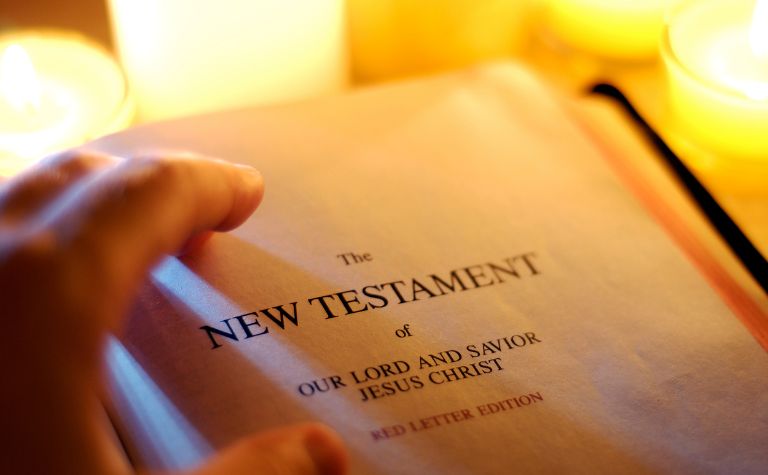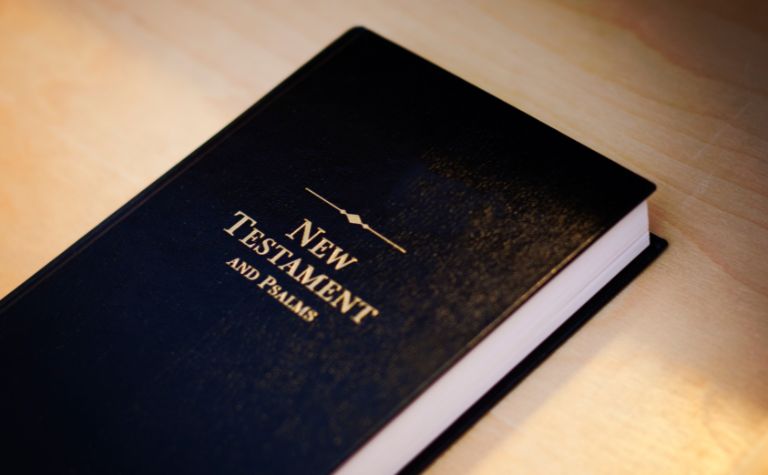The New Testament is the most significant collection of writings in world history. Each gospel, letter, historical account, and sermon describe the life and ministry of Jesus of Nazareth and the community of his followers. Like learning each book’s purpose, setting, and audience, knowing who wrote each one helps readers understand their message and meaning for today.
Paul of Tarsus wrote 13 of the 27 books of the New Testament. John, son of Zebedee, wrote five. Luke and Peter each wrote two. Matthew, Mark, James, and Jude each wrote one. No one knows who wrote Hebrews, though some guess it was Paul, Luke, Apollos, Barnabas, or someone else.
Are the Gospels anonymous? Who did the first leaders in church identify as their authors? Who wrote Acts? Which 13 books did Paul write? Who wrote the General Epistles? Who identifies himself four times as the author of Revelation? Keep reading to learn the answers to these questions and others.
Also, see How Many Chapters Are in the New Testament? to learn more.

The Gospels and Acts
Neither the Gospels nor Acts include a byline like many New Testament letters do (more below). Though Luke addresses his Gospel and Acts to an individual (i.e., “Theophilus,” Luke 1:3; Acts 1:1), they generally don’t have the characteristics of letters. Instead, the Gospels read like biographies of Jesus.
Yet, the Gospels aren’t merely historical accounts. They intend to persuade readers to follow Jesus. “Jesus did many other signs in the presence of the disciples, which are not written in this book; but these are written so that you may believe that Jesus is the Christ, the Son of God, and that by believing you may have life in his name” (John 20:30-31, ESV).
| Book | Author |
|---|---|
| Matthew | It’s technically anonymous, but early tradition identifies Matthew |
| Mark | It’s technically anonymous, but early tradition identifies John Mark |
| Luke | It’s technically anonymous, but internal and external evidence identifies Luke |
| John | It’s technically anonymous, but internal and external evidence identifies John, son of Zebedee |
| Acts | It’s technically anonymous, but internal and external evidence identifies Luke |
Matthew: Early church fathers like Papias, Eusebius, and Origen identify Matthew as the author of the first Gospel. Matthew was a tax collector in Capernaum (Matt. 9:9). Also called Levi (Mark 2:14), Matthew became a follower of Jesus and tried to convince other Jews that Jesus was the Messiah.
Mark: Early church fathers like Irenaeus, Clement of Alexandria, Origen, and Jerome identified John Mark as the author of the second Gospel. Mark was the son of Mary (there are six Marys in the New Testament) in Jerusalem (Acts 12:12) and the cousin of Barnabas (Col. 4:10).
Luke: Early church fathers like Irenaeus, Tertullian, Clement, Origen, Jerome, and Eusebius identified Luke as the author of the third Gospel. Luke was a Gentile physician (Col. 4:14) and an occasional traveling companion of Paul (more below). He also wrote the book of Acts.
John: Early church fathers like Irenaeus, Theophilus of Antioch, Clement of Alexandria, Origen, and Hippolytus identified John, son of Zebedee, as the author of the fourth Gospel. The Gospel has many similarities with the letters 1-3 John and the book of Revelation.
Acts: Early church fathers like Irenaeus, Clement of Alexandria, Tertullian, and Origen identified Luke as the author of Acts. The medical vocabulary used in Acts supports the view that “Luke, the beloved physician” (Col. 4:14) wrote it. Luke accompanied Paul at Troas (16:11) and on parts of his missionary travels (16:10-17, 20:5-21:18, 27:1-28:16).
Also, see How Many Books Are in the New Testament? to learn more.

The Writings of Paul
The genre or style of Paul’s writings is epistle, i.e., letters he wrote mainly to churches, like the one in Rome or Corinth. However, he wrote four of his letters to individuals: Timothy, Titus, and Philemon.
| Book | Author |
|---|---|
| Romans | Paul wrote Romans (1:1; 15:25; 16:3) |
| 1-2 Corinthians | Paul wrote 1 and 2 Corinthians (1 Cor. 1:1; 2 Cor. 1:1) |
| Galatians | Paul wrote Galatians (1:1; 5:2) |
| Ephesians | Paul wrote Ephesians (1:1; 3:1) |
| Philippians | Paul wrote Philippians (1:1) |
| Colossians | Paul wrote Colossians (1:1; 4:18) |
| 1-2 Thessalonians | Paul wrote 1 and 2 Thessalonians (1 Thess. 1:1; 2 Thess. 1:1) |
| 1-2 Timothy | Paul wrote 1 and 2 Timothy (1 Tim. 1:1; 2 Tim. 1:1) |
| Titus | Paul wrote Titus (1:1) |
| Philemon | Paul wrote Philemon (1:1, 9, 19) |
Unlike the Gospels and Acts, Paul’s letters aren’t anonymous. Instead, it was his practice to identify himself in the introduction of each one. For example, Galatians 1:1-2 reads, “Paul, an apostle — not from men nor through man, but through Jesus Christ and God the Father, who raised him from the dead — and all the brothers who are with me, To the churches of Galatia” (ESV).
Like the Gospels and Acts, several early church fathers identified Paul with the 13 New Testament letters that include his byline, including Clement of Rome, Ignatius, Polycarp, and Justin Martyr.
Also, see What Language Was the New Testament Written In? to learn more.

The General Epistles and Other Writings of John
The last nine books of the New Testament consist of the General Epistles (Hebrews, James, 1-2 Peter, and Jude) and the other writings of John, son of Zebedee (1-3 John and Revelation).
Hebrews is theologically rich and exalts the person and work of Jesus Christ, yet its form and style are unusual. It’s not a Gospel, a historical account, or simply a letter. Instead, many scholars believe it was originally a sermon that someone recorded and then sent to other churches and Christians as a letter.
| Book | Author |
|---|---|
| Hebrews | Unknown; suggestions include Paul, Luke, Apollos, Silas, Barnabas, Mark, and Priscilla |
| James | James, the half-brother of Jesus (Matt. 13:55; Gal. 1:19) |
| 1-2 Peter | Peter wrote 1 and 2 Peter (1 Pet. 1:1; 2 Pet. 1:1) |
| 1-3 John | They are technically anonymous, but early tradition identifies John |
| Jude | Jude, the half-brother of James and Jesus (Jude 1:1; cf. Matt. 13:55; Gal. 1:19) |
| Revelation | John wrote Revelation (1:1, 4, 9; 22:8) |
Hebrews: Hebrews has an unconventional introduction (1:1-4), which is unlike other New Testament books. Though scholars from the early church to the modern day make educated guesses about who its author is (see above), most admit not knowing for sure. Many cite Origen, who famously said, “Who the author of Hebrews is, God truly knows.”
James: The first verse of the letter names the author, “James, a servant of God and of the Lord Jesus Christ, To the twelve tribes in the Dispersion: Greetings” (ESV). There are four men named James in the New Testament. The early church fathers identified Jesus’ half-brother and leader in the early church as the author (Matt. 13:55, Gal. 1:19; Acts 12:17, 15:13-21, 21:8).
1-2 Peter: The first verse of each letter names its author, “Peter, an apostle of Jesus Christ” (1 Pet. 1:1) and “Simeon Peter, a servant and apostle of Jesus Christ” (2 Pet. 1:1). There are similarities between Peter’s speeches in Acts and his New Testament letters (Acts 2:32-36; cf. 1 Peter 1:21).
1-3 John: The three letters that early church fathers like Irenaeus, Clement of Alexandria, and Tertullian identified with John, are technically anonymous. Scholars point out many similarities between these letters, the Gospel of John, and Revelation regarding vocabulary, style, and themes.
Jude: The first verse of the letter names the author, “Jude, a servant of Jesus Christ and brother of James, To those who are called, beloved in God the Father and kept for Jesus Christ” (ESV). Most scholars believe the author was Jude, the half-brother of Jesus, (Matt. 13:55, Mk. 6:3), who became a believer after Jesus’ resurrection from the dead (John 7:5; Acts 1:14).
Revelation: The author calls himself John three times in the first chapters, “The revelation of Jesus Christ, which God gave him to show to his servants the things that must soon take place. He made it known by sending his angel to his servant John” (1:1; also see 1:4 and 1:9; cf. 22:8).
Early church fathers identified John, son of Zebedee, as the author of Revelation. The vocabulary and style share similarities with the Gospel of John. A lot of terms are also similar (e.g., “Word” in Rev. 19:13; John 1:1, 1:14, and 1 John 1:1).
References:
[1] Tyndale Concise Bible Commentary by Robert B. Hughes and J. Carl Laney.
[2] Encountering the New Testament by Walter Elwell.
Related Questions
Over 2,000 years ago, people who walked and talked with Jesus of Nazareth wrote the 27 books of the New Testament. The drive to preserve and spread Jesus' teachings and stories about him led the...
The New Testament records stories and teachings about the life, ministry, and followers of Jesus of Nazareth. Each book is either written by an apostle of Jesus (e.g., Paul) or a close companion to...
